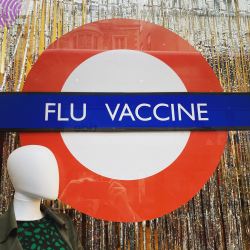Flu season is here. With COVID-19 still wreaking havoc in certain parts of the US, getting a flu shot is more important this year than ever before.
This year’s influenza (“flu”) season, which has already begun in some parts of the country, revs up in November, and last until spring, will be made more ominous than ever by the current high numbers of COVID-19 cases in many parts of the nation. The coincidence of infections in the population by the two highly infectious respiratory viruses has the potential to create a “twindemic” for our already stressed healthcare infrastructure.
As of October 7th, daily cases of COVID-19 nationally were about 105,000 and deaths were over 2,400. A Wall Street Journal headline and sub-hed captured the gravity of the situation: “Hospitals Swamped With Delta Cases Struggle to Care for Critical Patients. Some facilities don’t have the staff or capacity to provide urgent treatment to everyone, and people have died waiting.”
With public health experts expecting an uptick in cases of both COVID-19 and flu as winter approaches and people tend more often to be in crowded, poorly ventilated, indoor spaces, we need to “flatten the curve” of infections by both viruses.
The morbidity and mortality from the flu vary significantly from year to year, but the CDC estimates that it has caused millions of infections, hundreds of thousands of hospitalizations, and tens of thousands of deaths every flu season since 2010 – every season, that is, except the last two, because of the widespread COVID-19 precautions, which also prevented the flu: masking, distancing, handwashing, school closures, and so on. But with many schools having resumed in-person instruction and businesses and entertainment venues reopening, people are out and about more than during the past two flu seasons. Moreover, the low number of cases of flu during the past two seasons means that the levels of post-infection immunity are low, possibly portending a particularly bad year for flu outbreaks.
Therefore, it is especially imperative to prevent infections from both flu and SARS-CoV-2 (which causes COVID-19) with the tools at our disposal. The preventative measures recommended for COVID-19, which include wearing a mask, social distancing, frequent hand-washing, and avoiding crowded, poorly ventilated spaces, also works for the flu and other respiratory viruses. And of course, there is another potent weapon to prevent infections: vaccines. Even with aggressive campaigns, we were barely able to vaccinate half the population during the past two flu seasons.
We are probably headed for the same problem this fall. A survey of more than 1,000 U.S. adults commissioned by the National Foundation for Infectious Diseases (NFID) found that while more than 60% of Americans agreed the flu shot was the best way to prevent flu deaths and hospitalizations, 44% said they were unsure about or not planning to get a flu vaccine this year. NFID's medical director, Dr. William Schaffner, said that overall vulnerability to flu could be high this year, “with relaxed Covid-19 mitigation strategies, increased travel and the reopening of schools.” A hint of the validity of Dr. Schaffner’s prediction is that other respiratory infections have already returned, including RSV, a common cause of pneumonia and bronchitis in babies and a serious threat to older adults.
An unprecedented surge of RSV that began during the summer shows what can happen in the absence of the COVID-19 precautions, according to Dr. Gregory Poland, a vaccinologist at Mayo Clinic in Rochester. He warned last month: “I’m not going to talk about a twindemic. I’m going to talk about a tridemic or a quaddemic. We’ve already seen evidence of it. We already have cases of influenza in Minnesota. We’ve already seen evidence of an RSV epidemic.”
Here are some points about flu vaccination that might help to reduce “vaccine hesitancy”:
The vaccine cannot give you the flu. All the flu vaccines that are injected consist of non-infectious fragments of the virus. The nasal spray (which is approved for administration to people from ages 2-49) consists of attenuated, or weakened, viruses, such that it, too, is non-infectious. Transient side effects include swelling and pain at the injection site, muscle aches, mild fatigue, or a low-grade fever.
Vaccine can reduce flu risk by up to 60%. The effectiveness of flu vaccines is usually in the range of 40-60%, which is important not only for protecting individuals by preventing a potentially lethal illness, but for preventing hospital capacity overload. Even when the flu doesn’t require hospitalization, it’s an unpleasant and debilitating illness, the signs and symptoms of which include high fever, chills, muscle aches, cough, congestion, runny nose, headaches, and fatigue.
Getting flu vaccine is more important than ever. It’s possible to be infected with flu and SARS-CoV-2 (the virus that causes COVID-19) simultaneously or sequentially, which is especially dangerous, because both can damage the lungs, compounding the effects of infection.
Flu vaccination is especially important in the very young and old, who have the highest mortality. There are high-dose versions of the injectable vaccines for seniors, whose immune response is generally less robust than that in younger people. For people who are averse to shots, nasal spray versions of flu vaccine are available (ages 2-49).
Get vaccinated as soon as possible. The flu season has begun, and it takes roughly two weeks for the immune system to generate an optimal immune response.
You can get the flu vaccine at the same time as the COVID-19 vaccine. The sooner, the better, for both.
Vaccination benefits you and others. “There are benefits to us as individuals: We’re less likely to get the flu. Even if we do develop the flu, we’re less likely to need to be hospitalized and it tends to be less severe if you get the vaccine,” said Dr. Kate Kirley, a family physician and director of chronic disease prevention at the AMA. “It is also about protecting others — your family, friends, community members.”
As to where to go for the shot or nasal spray immunization, there are lots of options, including your primary-care physician’s office, HMO (health maintenance organization), public health clinic, or the local pharmacy. But the important thing is, don’t put it off. Do it now!
Note: An abbreviated version of this article was published in the Washington Examiner.

